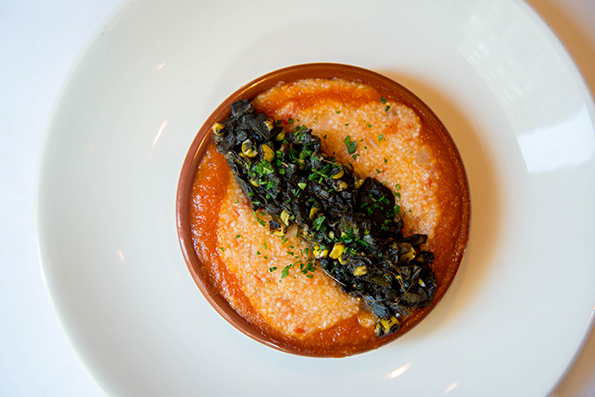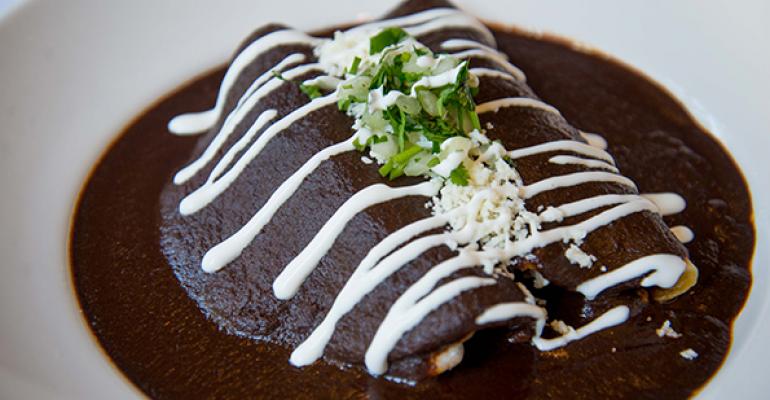Rosa Mexicano, a 17-unit fine-dining Mexican chain based in New York City, celebrated its 30th anniversary this month with a special menu inspired by dishes originally developed by founding chef Josefina Howard.
Tom Dillon, who joined Rosa Mexicano as its chief executive about a year ago, is taking the occasion to rework the chain’s whole menu, with new dishes that speak to the restaurant’s authentic Mexican heritage.
Before joining Rosa Mexicano, Dillon was president and chief operating officer of Los Angeles-based Patina Restaurant Group. He previously held that same position at Richard Sandoval Restaurants. Prior to that he was president and CEO of Pret A Manger USA.

Over a lunchtime sampling of some of the items on the restaurant’s 30th anniversary “Desde 1984” menu, Dillon discussed how he was working to evolve the chain, as well as Americans’ perception of Mexican food.
When I came here, I felt that Rosa needed to get back to its roots and define what it was and where it was in the conversation that’s happening [in the United States about Mexican food]. I felt really strongly that the kind of authentic and regional nature of Mexican cuisine is incredibly relevant, and there are so many aspects to Mexican cuisine that are big trends now. Snout-to-tail, for example. Obviously in Mexico, where there’s sweetbreads and intestine, you have it all. And farm-to-table: Everything in Mexico was farm-to-table because you didn’t have refrigeration. It’s highly local food.
Even with a lot of the dietary things going on today, [corn] tortillas are gluten free, and we’re doing a lot of grilled, lightly braised meats instead of a lot of fried food.
Even from a hospitality perspective, I always felt that the unique thing about Mexican food was that it’s really to be shared, first of all, and secondly that it’s all about making people feel comfortable and looked after in a restaurant.
If you look at those four themes — the dietary themes, the more casual, approachable nature of dining, farm-to-table and snout-to-tail — those are incredibly relevant things right now that really are the soul of what Mexican food’s about. I felt that getting back to the original vision of what Josefina had when she did this was the most relevant place for us to be, and it defined what the experience was. So we’re taking the opportunity with the 30th anniversary to re-kick that off.
What kinds of changes have you made?
We’re highlighting the more regional nature of the dishes. Of the dishes we’re going to taste today, we’ve got the mole Poblano. The great story about that mole in particular — everyone takes credit for it, but the one we’re going to accept is that the nuns of Santa Rosa, which was a convent in Puebla, created the mole Poblano.
We’re going to do a Veracrúzana dish. Veracrúz is part of coastal Mexico, but it was very heavily influenced by the Spanish. Cortéz 500 years ago built the first Spanish colony in Veracrúz, so the food is much more heavily influenced by Spain, and the Veracrúzana [cuisine] could almost be Italian; it’s made with capers and olives. And then the pibil is a very traditional dish from the Yucatán. We’re trying to put things on the menu that we think make Mexican food great, and even for our staff and chefs to build more of a culture that’s meaningful. It’s okay to celebrate what’s traditional rather than what’s happening now.
How have your customers responded?
Richard [Sandoval] and I had a bunch of restaurants in D.C., and one was in Tysons Corner, which is this super-affluent, big suburb of D.C., so it’s going to be your better-educated, high-income suburbanites, and I’d get off the plane from Mexico, land in Reagan Airport, take a cab out and walk into the restaurant, and within 10 minutes the manager would say, ‘Can you go talk to this table? They’re really upset about the food. They say it’s not Mexican,’ and I would get lectured for five minutes that they didn’t know who this Sandoval guy was, but this wasn’t authentic Mexican food. And I would try to assure them that deep-fried burritos were not authentic Mexican food, but in a nice way. That’s the hard part. A lot of times when you have a chef associated with it you can say, ‘The chef does it this way,’ and people accept that. It’s harder to say, ‘Actually, this really is Mexican food.’
Value equation
(Continued from page 1)
So much damage was done by Tex-Mex, with Americans thinking they understood Mexican food and really defining it as rice, cheese, beans, big plates of stuff with a little bit of spice. It’s definitely a challenge for us to get past that, but I think that’s the way forward for us — embracing regional authenticity, and the menu we’re doing now is kind of going forward with the brand.
Here we have chicken pibil with achiote, plantains from Yucatán and pickled habanero.
It would typically be pork, right?
Chicken would be more in Oaxaca than the Yucatán.
I love the Veracrúzana dish [mahi mahi with tomatoes, bell peppers, poblanos, pickled jalapeños, olives, mint and cilantro]. It’s one of the things I put on the menu, but it’s one of those bridges too far for people. We’re trying to calibrate how far we can take people. The mole Poblano we’re good with, the pibil people will accept, the Veracrúzana, I really love it, but we get so much [push back].

What’s your average per person check?
We have four pricing tiers, so in New York, without tax and tip, it’s around $40 at dinner; in D.C., it’s around $38; and in markets like Atlanta, Miami and Minneapolis, it’s more like $32.
If you talk to people in New York, they say, ‘Oh my God, that’s nothing,’ but if you talk to people who are used to getting three tacos for $8.99, and there’s rice and beans on the side — especially when you move away from wealthy urban couples and you go to families, and they want the whole family to eat for $50. … Value, as with most foods, but also with Mexican food, has been driven by volume of food on the plate as opposed to quality food on the plate.
But if someone looks at the right side of the menu at Rosa Mexicano, at the prices, they should realize that they’re not coming for the value proposition, but for the experience, which seems like a good place for restaurants to be now, because it’s the high end of casual dining that’s doing well — the experiential places.
We’re not expensive for fine dining, but for Mexican food we are, and so we need people to really understand it. We’re focusing on telling more of that story with our 30th anniversary menu, so people will be more like, ‘OK, it’s a $22 enchilada, but it’s from a certain place, and no, I’ve never had a flavor quite like that and I really do enjoy that.’”
Are you going to keep these dishes on the menu for a while?
The Veracrúzana and the pibil have been on the menu for a while, the mole enchilada and the huitlacoche tamal we just put in for the 30th anniversary. We’re going to try to use menu changes throughout the year to tie back to the more regional Mexican food.
Contact Bret Thorn at [email protected].
Follow him on Twitter: @foodwriterdiary

